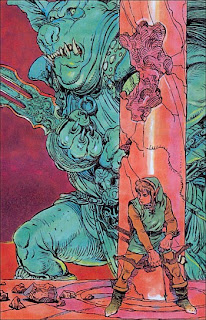
40 hours in, The Legend of Zelda: Twilight Princess is just as good as I had imagined. It is rare in this day and age for hyped products (and Zelda certainly is hyped at least among gamers) to live up to expectations. The game isn’t perfect, and I had wished Miyamoto had listened to his team members for creating a Twilight Princess SP version for Wii owners, but that's really a minor quibble and gives me something to look forward to in their next Wii-specific Zelda title.
The challenge is there, and obviously this game is not ‘hardcore’ hard, it’s accessible enough for any able men and women (also children, never forget them) who are willing to tackle this gargantuan quest. My early worries about the ‘standard’ right-handed Wii-mote controls being impossible for me a
 s a lefty has been disproved. But then again I’m a life long right-handed mouse user and found pointing the Wiimote right handed to be very natural and intuitive.
s a lefty has been disproved. But then again I’m a life long right-handed mouse user and found pointing the Wiimote right handed to be very natural and intuitive.But what I want to talk about today is the look of the game. Visually, everything I had hoped in my wildest dreams as a teenager 10 years ago writing for Nintendojo with Michael Veroni has been put into the game. In 1997, before The Ocarina of Time was released, my only frame of reference for how a it would feel to play a 3-D Zelda game was to look at some of the production paintings for A Link to the Past and the official art found in the Nintendo Power Player’s Guides.
Several images have always stuck with me. There was the picture of Link standing on top of Death Mountain looking down at Hyrule below, and perhaps the most striking image is that of a the Master Sword resting on its pedestal deep in the a verdant forest sanctuary, with beans of sunlight filtering through the forest canopy. Then there were the images from the official player’s guides that were not only artistically beautiful but embodied the look and feel of a true 3-D Zelda game. The scale of the images were epic and cinematic. I remember the picture of Link climbing on top of a rock outcrop only to discover the entrance to the a temple ruin and another one of Link hiding behind a half broken pillar, bow ready, while Ganon in his beast form stalks him.

In 3-D however, I was never quite pleased with Ocarina of Time’s handling of many of Zelda’s elements. The famous Lost Woods was turned into a series of boxed rooms with forest wall textures, and the Master Sword was found in the temple of time instead. In fact, while Ocarina of Time was visually great in 1998, many of the epic images I had of what a Zelda game should look like in 3-D were never realized. In Wind Waker (2003), the toonshaded look and limited selection of dungeons as well as the game's context (sailing between islands) failed to tap the GameCube's power to project the epic images of the artwork that have always stuck with me.
Thankfully it is in Twilight Princess that series producer Shigeru Miyamoto and director Eiji Aonuma finally put many of the elements into place. The Master Sword can now be found in its home inside the great forests of Hyrule. The landscapes of Hyrule have finally come alive, bloom lighting and all.
No comments:
Post a Comment